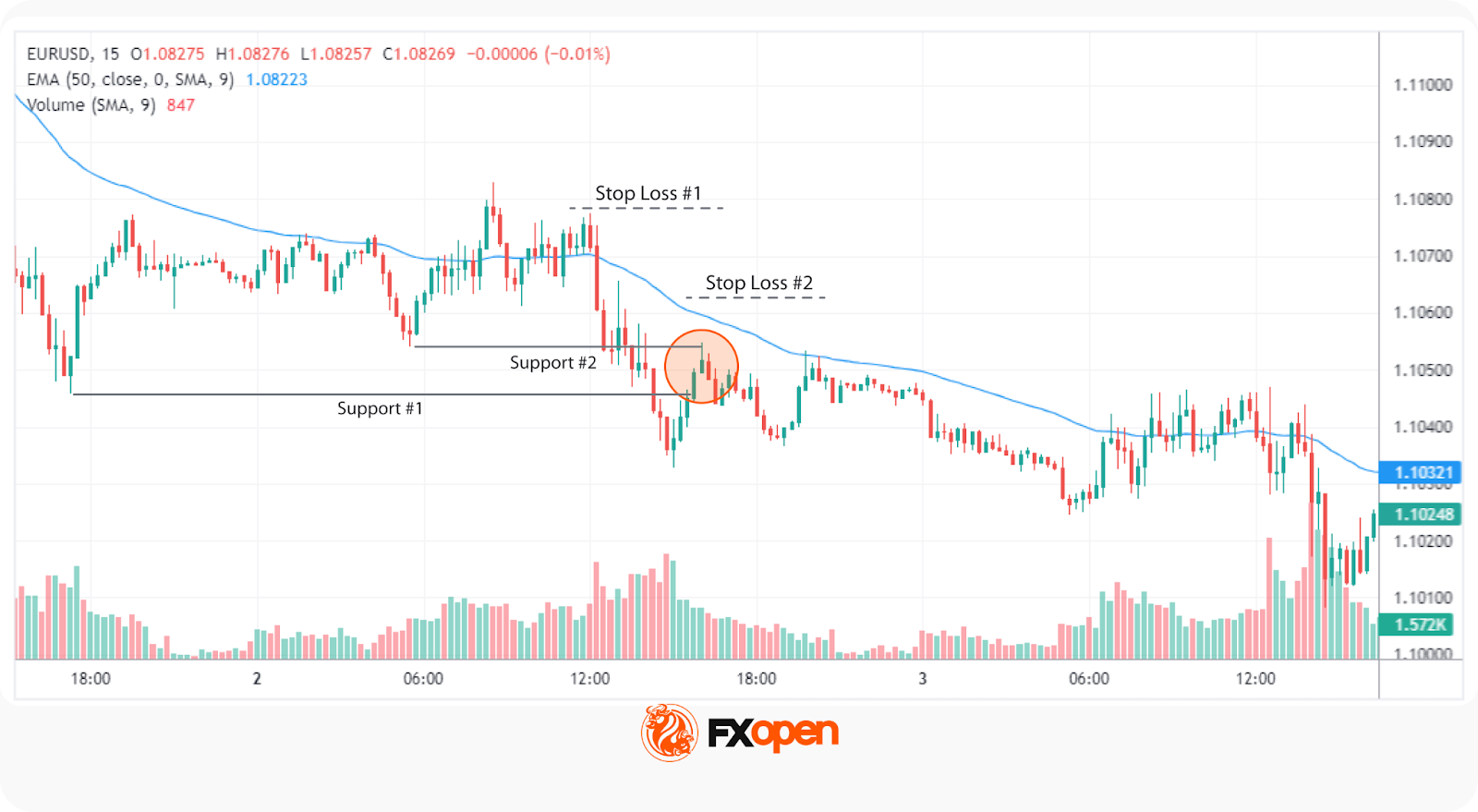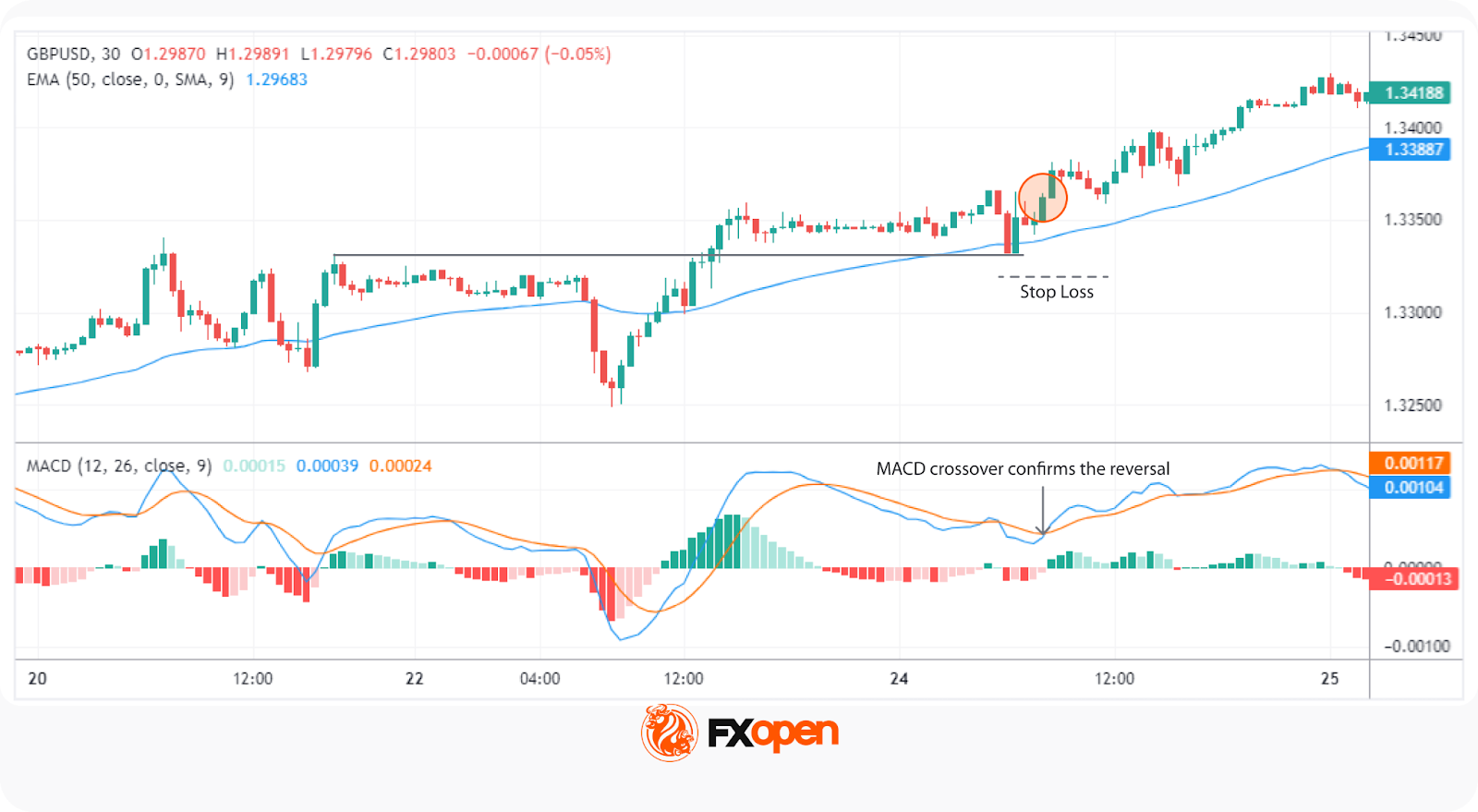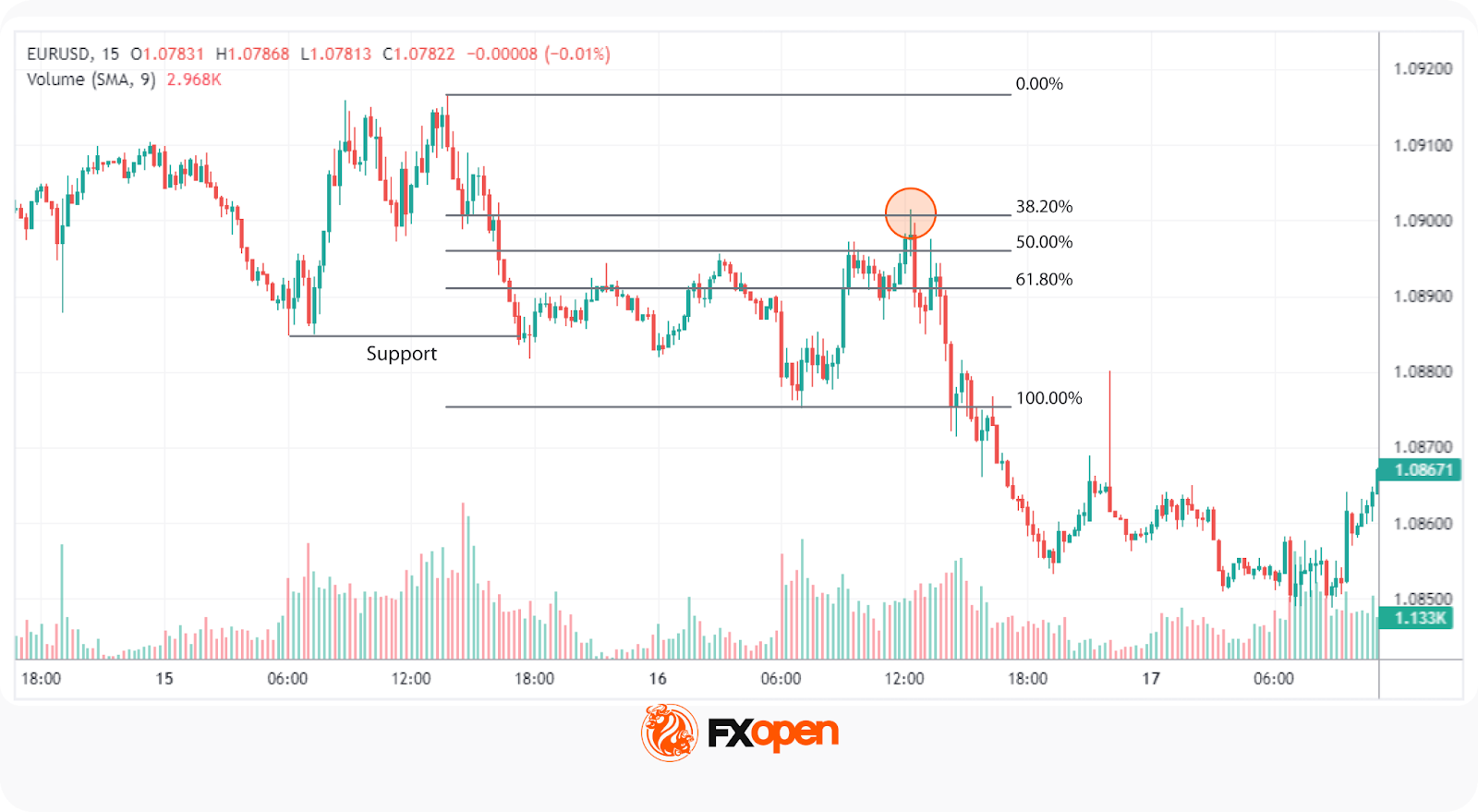FXOpen

Traders widely use strategies as structured approaches to entering and exiting the market. One of the most popular methods is the break and retest strategy, based on support and resistance levels. In this article, we explain the core principles of the strategy, how it works, and provide practical examples.
Understanding the Break and Retest Strategy

The break and retest strategy revolves around identifying key support and resistance levels on a price chart. When the price breaks through a support or resistance level, it signals a potential shift in market sentiment. For example, if a stock breaks above a resistance level, it suggests increasing buying interest. Traders then watch for the price to return to this newly broken level—known as a retest in trading. During the retest, the former resistance now acts as support, providing a potentially more attractive entry point for traders looking to join the trend.
This strategy aligns well with trending markets, where prices move consistently in one direction. It allows traders to take advantage of momentum while managing their entries.
How Traders May Apply the Break and Retest in Trading
Implementing the break and retest strategy involves a clear sequence of steps that traders follow to identify and act on potential market moves. Here’s a breakdown of how this strategy typically operates:
1. Identifying Key Levels
Traders begin by pinpointing significant support and resistance levels on their charts. Accurate identification is crucial, as these levels form the foundation of the strategy.
2. Monitoring for a Breakout
Once the key levels are established, traders watch for the price to break through one of these barriers, in line with a broader trend. A breakout occurs when the price moves decisively above resistance or below support, often accompanied by increased trading volume. This surge in volume indicates stronger market interest and can validate the breakout’s legitimacy.
3. Waiting for the Retest
After the breakout, the price typically retraces to test the broken level. For instance, if the price breaks above a resistance level, it may pull back to that same level, which now acts as support. This retest phase is critical as it offers a second confirmation of the breakout’s strength.
4. Confirming the Retest
During the retest, traders look for confirmation signals to ensure the breakout is genuine. These signals can include specific candlestick patterns, such as pin bars or engulfing candles, and continued high trading volume. Confirmation suggests that the new support or resistance level will hold, increasing the likelihood of a sustained trend.
5. Entering the Trade
With confirmation in place, traders often enter the market, aiming to ride the new trend. They might set stop-loss orders slightly below the new support (in the case of a breakout to the upside) or the new resistance (in case of a breakout to the downside).
6. Managing the Trade
Trade management involves setting target levels based on previous price action, e.g. significant swing points, and adjusting stop-loss orders as the trade progresses.
Break and Retest Strategy: Example

Consider this EURUSD 15-minute chart, which displays a clear bearish trend. This trend is highlighted by the 50-period Exponential Moving Average (EMA) sloping downward, with the price generally staying below it. Recently, the price broke below a key support level on higher-than-average volume, signalling the time to apply the break and retest strategy.
In this scenario, there are two support levels to monitor. The first is a more significant support level. Trading at this level can allow traders to enter the market quickly, though it comes with a less favourable risk-reward ratio.
The second support level is found within the recent brief retracement. This level might offer a more favourable risk-reward ratio, but there's a chance the price may not retrace deeply enough, potentially causing traders to miss the trade.
The entry point is identified by a candle with a wick longer than its body (a pin-bar on the 30m chart), indicating rejection of higher prices as the market retests the second broken support level. Once this candle closes, traders can enter a market order.
Stop losses would typically be placed either above the last major swing high or the 50-period EMA, depending on individual risk tolerance. Take-profit targets could be set at a 1:3 risk-reward ratio or at the next significant support level, where a price reversal may be anticipated.
How May Traders Confirm the Break and Retest Strategy?
The break and retest strategy trading involves integrating additional tools and techniques to refine trade decisions. Here are several methods traders consider:
1. Incorporating Additional Indicators

Using break and retest indicators like the Relative Strength Index (RSI) or the Moving Average Convergence Divergence (MACD) can provide valuable insights. For instance, an RSI crossing below 70 during a bearish breakout may indicate weakening momentum, supporting the retest. Similarly, the MACD crossing above its signal line or the MACD histogram rising above 0 can confirm the uptrend’s strength, aiding in more precise entry points.
You can explore these indicators and more than 1,200+ trading tools in FXOpen’s TickTrader trading platform.
2. Multi-Timeframe Analysis
Examining charts across different timeframes may help in gaining a broader market perspective. A breakout observed on a 4-hour chart gains additional confirmation when a strong trend is also visible on a daily chart. This alignment across timeframes increases the reliability of the trade setup.
3. Utilising Fibonacci Retracements

After a breakout, prices often retrace deeper into the previous high-low range—not always to the most extreme point. Applying Fibonacci retracements to the high/low of the breakout (high in a bearish breakout and low in a bullish scenario) and the new low or high may help identify strong retest points, particularly at the 38.2%, 50%, and 61.8% levels.
4. Incorporating Fundamental Analysis
Supporting technical breakouts with fundamental factors, such as economic reports or news events, strengthens the strategy. For example, a breakout aligned with positive economic data may have a higher probability of sustaining the new trend.
Advantages of the Break and Retest Strategy
The break and retest strategy has several advantages that make it one of the most popular trading approaches:
- Additional Confirmation: The retest serves as an additional validation of the breakout, boosting trader confidence in their entry decision and reducing hesitation.
- Strong Risk Management: Setting stop-loss orders based on the retest level provides a clear risk boundary.
- Alignment with Market Trends: This strategy naturally aligns trades with the prevailing market trend. By trading in the direction of the breakout, traders can take advantage of sustained movements.
- Versatility Across Markets: The breakout and retest strategy can be applied to various financial instruments, including forex, stocks, and commodities. Its adaptability makes it a valuable tool in diverse trading environments.
- Scalability and Flexibility: This strategy can be adapted to different timeframes and trading styles, making it popular among both short-term and long-term traders seeking to implement a consistent approach.
Disadvantages of the Break and Retest Strategy
While the break and retest strategy can be a powerful tool, traders may face several challenges when implementing it:
- False Breakouts: Not every breakout leads to a sustained trend. Sometimes, the price moves beyond a support or resistance level only to reverse shortly after. Recognising these false signals is crucial to avoid entering trades that may quickly turn against expectations.
- Market Conditions: According to theory, this strategy is more popular in trending markets. In sideways or highly volatile environments, breakouts can be less reliable, making it harder to distinguish a strong price movement from random swings.
- Timing the Retest: Accurately determining when the price will retest the broken level can be challenging. Entering too early may expose traders to higher risk, while waiting too long might result in missed trades if the retest doesn't occur as anticipated.
- Reliance on Confirmation Signals: While additional indicators like RSI or MACD can support the strategy, over-reliance on these tools can complicate decision-making. Traders balance multiple signals without becoming overwhelmed or confused.
- Emotional Discipline: Maintaining discipline during retests is critical. Traders might feel pressured to act quickly if the market moves unexpectedly, leading to impulsive decisions that deviate from their trading plan.
The Bottom Line
This strategy provides a structured approach for trading on breakouts and retests. Understanding how the price may behave after a breakout may support traders in their future decisions. One of the major advantages of the break and retest strategy is that it can be applied across different markets and timeframes. However, traders should note that break and retest trading requires consideration of market conditions and careful risk management.
If you want to put this strategy into practice across more than 700 markets, you can consider opening an FXOpen account and gain access to four advanced trading platforms, tight spreads, and low commissions from $1.50 per lot.
FAQ
What Is a Retest in Trading?
A retest occurs when the price returns to a broken support or resistance level after an initial breakout. It serves to confirm the strength of the breakout, which may help traders decide whether the new trend will continue or if the breakout was false.
What Is the Break and Retest Strategy?
The break and retest strategy involves identifying a breakout of a key support or resistance level and then waiting for the price to return to that level. Traders use this retest as a confirmation to enter the market, aiming to follow the new trend.
How Many Times Can I Backtest My Strategy?
Backtesting is typically done extensively across different market conditions and timeframes. According to theory, traders need to test a strategy on at least 100 trades to understand how it performs in various scenarios.
Does the Market Always Retest?
No, the market does not always retest broken levels. While retests are common, they are not guaranteed. Traders often use additional confirmation signals and be prepared for both possibilities when applying the break and retest strategy.
This article represents the opinion of the Companies operating under the FXOpen brand only. It is not to be construed as an offer, solicitation, or recommendation with respect to products and services provided by the Companies operating under the FXOpen brand, nor is it to be considered financial advice.
Stay ahead of the market!
Subscribe now to our mailing list and receive the latest market news and insights delivered directly to your inbox.








